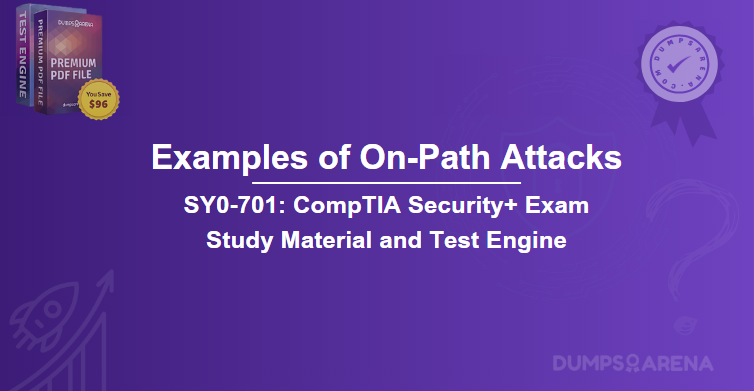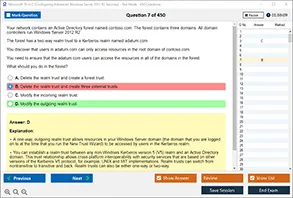Introduction
On-path attacks, formerly known as man-in-the-middle (MITM) attacks, are a significant cybersecurity threat where an attacker intercepts and potentially alters communication between two parties without their knowledge. These attacks can compromise data integrity, confidentiality, and authentication, making them a critical topic in cybersecurity certifications like CompTIA Security+ (SY0-701).
Understanding on-path attacks is essential for cybersecurity professionals, as they are frequently tested in the SY0-701 exam. This article explores various examples of on-path attacks, their mechanisms, prevention techniques, and their relevance to the CompTIA Security+ certification. Additionally, we’ll discuss how DumpsArena can help aspiring professionals prepare effectively for the exam with high-quality study materials.
What Are On-Path Attacks?
An on-path attack occurs when a malicious actor positions themselves between two communicating entities (e.g., a user and a server) to eavesdrop or manipulate data. Unlike passive eavesdropping, on-path attackers actively interfere with communications, making them more dangerous.
Key Characteristics of On-Path Attacks:
- Interception – The attacker captures data transmitted between victims.
- Modification – The attacker alters the data before forwarding it.
- Impersonation – The attacker pretends to be a legitimate party.
These attacks exploit vulnerabilities in unsecured networks, weak encryption, or flawed authentication protocols.
Examples of On-Path Attacks
1. ARP Spoofing (ARP Poisoning)
- How It Works: The attacker sends falsified Address Resolution Protocol (ARP) messages to associate their MAC address with the IP address of a legitimate device.
- Impact: All traffic meant for the victim is redirected to the attacker.
- Prevention: Use ARP inspection tools, static ARP entries, and network segmentation.
2. DNS Spoofing (DNS Cache Poisoning)
- How It Works: The attacker corrupts the DNS cache to redirect users to malicious websites.
- Impact: Victims may unknowingly visit phishing sites.
- Prevention: Implement DNSSEC (DNS Security Extensions) and monitor DNS traffic.
3. HTTPS Spoofing (SSL Stripping)
- How It Works: The attacker downgrades an HTTPS connection to HTTP, making traffic unencrypted.
- Impact: Sensitive data (passwords, credit cards) is exposed.
- Prevention: Enforce HSTS (HTTP Strict Transport Security) and use VPNs.
4. Wi-Fi Eavesdropping (Evil Twin Attack)
- How It Works: The attacker sets up a rogue Wi-Fi hotspot with a legitimate-sounding name.
- Impact: Users connect to the fake network, allowing the attacker to intercept data.
- Prevention: Avoid public Wi-Fi, use VPNs, and verify network authenticity.
5. Session Hijacking
- How It Works: The attacker steals a valid session token to impersonate a user.
- Impact: Unauthorized access to accounts (banking, email).
- Prevention: Use multi-factor authentication (MFA) and secure session management.
6. BGP Hijacking
- How It Works: The attacker manipulates Border Gateway Protocol (BGP) routes to redirect internet traffic.
- Impact: Large-scale data interception (e.g., government or corporate espionage).
- Prevention: Implement BGPsec (BGP Security) and monitor routing tables.
Role of On-Path Attacks in SY0-701 Exam (CompTIA Security+)
The CompTIA Security+ (SY0-701) certification validates foundational cybersecurity skills, and on-path attacks are a crucial topic in:
1. Domain 1.0: General Security Concepts
- Understanding attack types (MITM, spoofing, hijacking).
- Differentiating between passive and active attacks.
2. Domain 2.0: Threats, Vulnerabilities, and Mitigations
- Identifying attack vectors (Wi-Fi, DNS, ARP).
- Implementing countermeasures (encryption, MFA, network monitoring).
3. Domain 3.0: Security Architecture
- Designing secure networks to prevent interception.
- Applying Zero Trust and defense-in-depth strategies.
4. Domain 4.0: Security Operations
- Detecting on-path attacks using SIEM (Security Information and Event Management).
- Responding to incidents involving intercepted communications.
Aspiring professionals must master these concepts to pass the SY0-701 exam and excel in cybersecurity roles.
How DumpsArena Helps in SY0-701 Exam Preparation?
Preparing for the CompTIA Security+ (SY0-701) exam requires reliable study resources. DumpsArena offers:
1. Updated Exam Dumps
- Real SY0-701 practice questions with verified answers.
- Simulated exam environment for better preparation.
2. Detailed Explanations
- In-depth explanations of on-path attack scenarios.
- Step-by-step solutions for complex security concepts.
3. Performance Tracking
- Identify weak areas (e.g., attack mitigation, network security).
- Focus on high-weightage topics for better exam performance.
4. 100% Pass Guarantee
- Trusted by thousands of successful candidates.
- Regularly updated content aligned with CompTIA’s latest syllabus.
By using DumpsArena, candidates gain confidence in tackling on-path attack-related questions and other critical CompTIA exam topics.
Preventing On-Path Attacks: Best Practices
1. Use Strong Encryption (TLS 1.3, VPNs)
- Ensures data remains confidential even if intercepted.
2. Implement Multi-Factor Authentication (MFA)
- Prevents session hijacking and unauthorized access.
3. Monitor Network Traffic (IDS/IPS, SIEM)
- Detects anomalies like ARP spoofing or DNS poisoning.
4. Educate Employees on Security Awareness
- Avoid phishing scams and fake Wi-Fi hotspots.
5. Regularly Update Systems
- Patch vulnerabilities that attackers exploit.
Conclusion
On-path attacks remain a severe threat in cybersecurity, and understanding them is vital for the CompTIA Security+ (SY0-701) exam. From ARP spoofing to BGP hijacking, these attacks exploit network weaknesses, making robust defenses necessary.
For exam success, candidates should leverage DumpsArena’s high-quality SY0-701 dumps, ensuring they grasp attack mechanisms and mitigation strategies. By combining theoretical knowledge with practical defenses, professionals can secure networks effectively and advance their cybersecurity careers.
Get Accurate & Authentic 500+ Comptia SY0-701 Exam Questions
1. What is an on-path attack?
A) An attack where malware spreads through email attachments
B) An attack where the attacker intercepts and possibly alters communication between two parties
C) An attack where a hacker guesses passwords repeatedly
D) An attack that floods a network with excessive traffic
2. Which of the following is an example of an on-path attack?
A) Phishing
B) Man-in-the-Middle (MITM)
C) Denial-of-Service (DoS)
D) SQL Injection
3. In an on-path attack, the attacker typically:
A) Deletes files on the victim's computer
B) Acts as a relay between two communicating parties
C) Sends spam emails to multiple users
D) Encrypts the victim's data for ransom
4. Which attack involves intercepting and modifying DNS responses?
A) DNS Spoofing
B) Brute Force Attack
C) Cross-Site Scripting (XSS)
D) Zero-Day Exploit
5. What is a common goal of an on-path attack?
A) To corrupt hardware
B) To steal sensitive data like login credentials
C) To physically damage a server
D) To create fake social media accounts
6. Which of the following is NOT an on-path attack?
A) Session Hijacking
B) ARP Spoofing
C) Keylogging
D) SSL Stripping
7. How can an on-path attack be prevented?
A) Using strong passwords
B) Encrypting communications (e.g., HTTPS, VPN)
C) Installing an antivirus
D) Disabling firewalls
8. What type of on-path attack downgrades secure HTTPS connections to HTTP?
A) SSL Stripping
B) Buffer Overflow
C) Pharming
D) Ransomware
9. Which attack involves poisoning the ARP cache to redirect traffic?
A) IP Spoofing
B) ARP Spoofing
C) MAC Flooding
D) SYN Flood
10. An attacker secretly relays and alters Wi-Fi communications between two devices. This is an example of:
A) Evil Twin Attack
B) Smurf Attack
C) Replay Attack
D) Dictionary Attack



